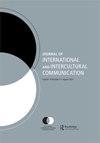The subcontinent speaks: Intercultural communication perspectives from/on South Asia
IF 2.2
Q2 COMMUNICATION
Journal of International and Intercultural Communication
Pub Date : 2020-04-02
DOI:10.1080/17513057.2020.1745440
引用次数: 3
Abstract
That this special issue has seen the light of day is primarily due to the vision of Todd Sandel, the outgoing editor of the Journal of International and Intercultural Communication, who readily identified the relative lack of visibility of South Asia focused intercultural communication research, suggested a special issue, and offered us total editorial discretion over the details. Thanks are also due, in equal part, to the many colleagues and peers who reviewed the articles that comprised this issue. We are proud to have had the opportunity to edit this special issue focused on intercultural research from/on South Asia. In the call for papers for this issue, we asked potential contributors to “showcase the multiple, contested and conflicting understandings around culture, identity, and power that inhabit the South Asian context.” One of our primary goals for this special issue is complicating and broadening the academic discourse on South Asia. This was a primary objective in selecting the articles that comprise this issue. As we explain below, the six articles respond to this call in important and intersecting ways. If critical intercultural studies in Communication refers to a set of practices that explore how “power, context, socio-economic relations, and historical/structural forces [constitute] and shape culture and intercultural encounters, relationships and contexts” (Halualani & Nakayama, 2013, p. 2), then the broad rationale of this issue is to crystallize these practices within the South Asian context. The point, of course, is not to engender some sort of fundamental South Asian exceptionalism, but to contemplate on how the abovementioned set of practices are manifest within that region. Here, we recognize that we stand on the shoulders of scholars before us – this move to de-parochialize the “inter” in intercultural communication has a long and storied history, and we recognize the work of the many scholars in our discipline that have allowed for the articulation of what we are attempting here. But first, a bit of context on terminology – the terms “Indian subcontinent” (or simply, “subcontinent”) and “South Asia” are often used interchangeably to refer to the region that corresponds to the nation-states of Afghanistan, Bangladesh, Bhutan, India, Maldives, Myanmar, Nepal, Pakistan and Sri Lanka. However, the difference between the terms is worth pause – the Indian subcontinent is primarily a geological term (referencing the peninsula created from the collision between Indian and Asian tectonic plates in the Cenozoic era), while South Asia is used in a political sense to refer to the contemporary nationstates that comprise the region and the relationships among them – consider the multilateral South Asian Association for Regional Cooperation, or SAARC, as an exemplar for this次大陆说话:南亚的跨文化交流视角
《国际与跨文化交流杂志》即将离任的编辑托德·桑德尔(Todd Sandel)的远见卓识使这一期特刊得以问世,他很容易就发现了以南亚为重点的跨文化交流研究相对缺乏知名度的问题,提出了一期特刊的建议,并为我们提供了对细节的全面编辑自由。同样,我们也要感谢审阅本期文章的许多同事和同行。我们很荣幸有机会编辑这期关于南亚跨文化研究的特刊。在本期的征稿中,我们要求潜在的撰稿人“展示南亚背景下对文化、身份和权力的多重、有争议和相互冲突的理解”。本期特刊的主要目标之一是使有关南亚的学术论述复杂化并扩大其范围。这是选择本期文章的主要目的。正如我们在下面解释的那样,这六篇文章以重要而交叉的方式回应了这一呼吁。如果传播学中的批判性跨文化研究指的是一套探索“权力、背景、社会经济关系和历史/结构力量[构成]和塑造文化和跨文化相遇、关系和背景”的实践(Halualani & Nakayama, 2013,第2页),那么这个问题的基本原则就是在南亚背景下明确这些实践。当然,问题的关键不是要产生某种根本性的南亚例外论,而是要思考上述一系列做法如何在该地区体现出来。在这里,我们认识到,我们站在前人学者的肩膀上——在跨文化交流中去狭隘化“inter”的行动有着悠久而传奇的历史,我们认识到,在我们的学科中,许多学者的工作使得我们在这里所尝试的东西得以清晰地表达出来。但首先,我们来了解一下术语的背景——“印度次大陆”(或简称“次大陆”)和“南亚”这两个词经常被交替使用,指的是阿富汗、孟加拉国、不丹、印度、马尔代夫、缅甸、尼泊尔、巴基斯坦和斯里兰卡等民族国家所在的地区。然而,这两个术语之间的差异值得深思——印度次大陆主要是一个地质术语(指印度和亚洲构造板块在新生代碰撞产生的半岛),而南亚在政治意义上用于指构成该地区的当代民族国家及其之间的关系——考虑多边南亚区域合作联盟,或SAARC,作为一个例子
本文章由计算机程序翻译,如有差异,请以英文原文为准。
求助全文
约1分钟内获得全文
求助全文
来源期刊

Journal of International and Intercultural Communication
COMMUNICATION-
CiteScore
3.80
自引率
12.50%
发文量
19
 求助内容:
求助内容: 应助结果提醒方式:
应助结果提醒方式:


